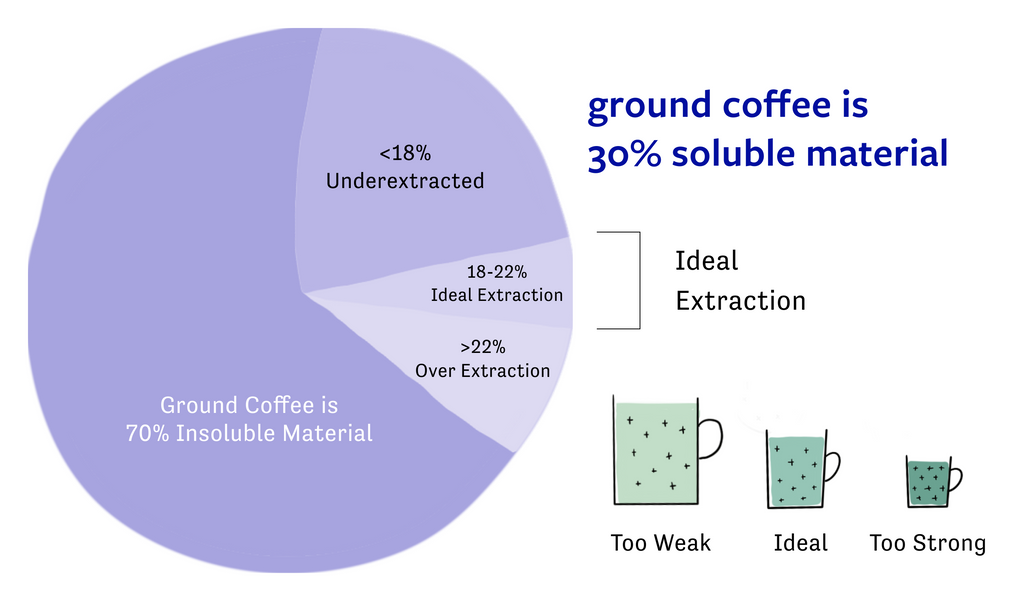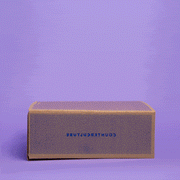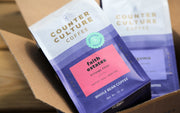The size of your coffee grounds can radically change how your brewed coffee tastes. In this blog, we’ll dive into the essentials of how to pick the right grind size for your brew.
We’re big believers in whole-bean coffee at Counter Culture Coffee. Not only does whole-bean coffee retain its freshness longer than ground coffee, but it also allows you to customize your grind size.
Before we get going, it’s important to note that grind size can only be controlled when using a burr coffee grinder, as opposed to a blade grinder. Learn all about why burr grinders > blade grinders and the inner workings of coffee grinders.
How Do I Choose a Grind Size?
Coffee Grinder Settings
Unfortunately, grind settings are far from universal. So, you won’t be able to find a recommended setting on your coffee grinder. Even when fresh from the factory, grinders have slight differences in motor speed, creating variability from unit to unit. More importantly than the motor, the burrs in any given grinder generate a suite of variables.
Coffee Extraction And Grind Size
Coffee is only 30% soluble material at max, but most brews taste best with less solubles—between 18–22%. While certain coffees and brewing methods may display pleasant flavors when extracted above 22%, it’s more common to experience a harsh, bitter taste in this range, indicative of over-extraction. When the extraction is lower than 18%, one typically experiences sharp, unbalanced acidity, resulting in a prevalently sour profile known as under-extraction.

The finer coffee is ground, the more surface area is exposed, granting water easier access to coffee’s soluble materials. As a result, a fine grind setting results in higher extraction yields than coffee ground on a coarse setting.
A great analogy for this is comparing rocks and sand. If you put sand in your brewing device and poured in water, the water would drip through very, very slowly. You would end up with some thick, sandy water. On the other hand, if you put in some rocks, the water would slid right on through those cracks and you would have basically the water you started out with.
Troubleshooting Grind Size
When your brew tastes off, start troubleshooting by adjusting the grind size. Rely on your sense of taste to determine the quality of extraction. Taste and brew time tell you which direction to go.

If the coffee taste harsh, bitter, and your mouth feels dry with an ashy aftertaste, your likely grinding too fine. Make your grounds bigger with a coarser grind.
If the coffee tastes weak, sour, or papery, you may be grinding too coarse. Try a finer grind.
Whatever you do, make sure you only adjust one brewing variable at a time—that way, you can track the impact of each adjustment on the brew.
Brewing Method And Grind Size
Different brewing techniques require different particle sizes depending on their shape and how long water and coffee are in contact. You can find brew guides for any given method and they will include a general reference for grind size. Fine, medium-fine, medium, medium-coarse, and coarse are often used as starting points that give a broad frame of reference.
Generally, brew methods with shorter water contact times, like espresso or AeroPress, require a finer grind size. Longer, slower brew methods, like French press, work best with a coarser grind.
Shorter brew time = finer grind
Longer brew time = coarser grind

Grind size is just one variable that affects coffee extraction. The shape of a coffee brewer, depth of the brew bed, type of filter used, water temperature, ratio of coffee to water, and contact time are some factors that can also impact extraction. As a result, grind size must always be considered in concert with these other brewing variables.
Adjusting Grind Size for Different Coffees
Once you establish a starting grind size for your brew method, assess the coffee you’re brewing. With all other brewing variables locked in, you will still notice a variation in extraction when switching between coffees. As a result of its long, complex journey from crop to cup, numerous factors impact the density and solubility of each coffee seed. How light or dark is the roast? If it’s darker, you’ll want to lean toward the coarser end of your grinding range. Next, evaluate details like the country of origin, variety, and elevation. A light-roast Catuai coffee grown at 1,650 meters in Honduras will generally need a coarser grind than a Kenyan SL28 variety grown at 1,800 meters.
Solubility is mainly dependent on the cellular structure of each coffee. Generally speaking, the more dense a coffee is, the more resistance it provides to water, making it less soluble than a lower-density counterpart. As a result, brewers typically must grind finer when brewing a high-density coffee to achieve the same level of extraction in a coffee with relatively lower density.
Let’s examine some of the significant variables that impact coffee density.
Coffee Variety, Plant Health, and Elevation
With hundreds of Arabica coffee varieties, each subspecies offers unique morphological traits, including differences in the physical characteristics of seeds. Some seeds are small and round, while others are elongated or broad. In any instance, each variety’s seeds may showcase different densities.
Coffee will also exemplify dense seeds due to the plant’s receiving adequate care through soil fertilization and regular pruning. Healthy coffee plants provide their fruit and seeds with abundant nutrients, resulting in higher density.
Higher-elevation coffees will almost always display higher seed density compared to lower-elevation counterparts. With more drastic fluctuations between daytime and nighttime temperatures, higher elevation climates stress the plant, causing it to focus its energy on fruit and seed production during the cooler nighttime hours.
When you’re brewing a single-origin coffee from Counter Culture Coffee, you can always find information about variety and elevation under the Harvest tab of a coffee’s product page!

Need to familiarize yourself with the characteristics of different varieties? Start experimenting with your brews and cataloging results for different origins! Try keeping a brewing diary, noting how each brew yields the best results. Over time, you’ll develop a sense of the broad characteristics of different coffees.
Roasting
The darker the roast on a coffee, the more its cellular structure is degraded, making it less dense. As a result, darker roasts are more readily soluble, requiring a coarser grind setting than lightly roasted coffee, which one should grind finer.
In addition to differences in solubility, darker roasts of coffee result in softer beans. While it may be imperceptible to the touch, the degraded cellular structure makes the coffee more elastic, changing how the seeds break during grinding. This change results in more fines in the ground coffee.
Fines
Softer coffees produce more fines—particles smaller than 200 microns produced when the coffee breaks. As a result of a higher concentration of fines, softer coffees extract faster. Generally speaking, it’s advised to grind such coffees at a coarser setting in order to minimize the production of fines.
While dark roasts produce a high volume of fines, there can be variability from coffee to coffee. Generally speaking, Ethiopian coffees tend to have more elasticity, requiring a slightly coarser grind compared to coffees from other origins that have been roasted to the same level.
Controlling your grind size is vital to getting the best flavors from your coffee. The finer you grind, the higher the rate of extraction will be, as long as all other variables remain fixed. Learn how to master one particular brewing method, then make adjustments with your grind size to find the best flavor for each and every coffee you brew!
Key Takeaways
- The darker the roast, the coarser the grind setting
- Ethiopian coffees require a slightly coarser grind compared to coffees from other origins that have been roasted to the same level.
- Grind finer when brewing coffees from higher elevations
- Shorter brew time = finer grind
- Longer brew time = coarser grind








